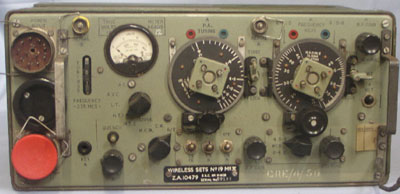
Unfortunately most 19 sets are found in far from original condition.
The sets were originally designed and built in the U.K. Other versions have been built in Canada and the U.S., including a version with English and Russian labels, many of which found their way to Australia.
The sets were also produced in Australia, AWA producing the No 19 Mk2 in February 1943, with a second production run in May 1944. There are also No 19 Mark2 /2 sets which are obviously Australian but much later production than the AWA sets.
The set was designed to be used in armoured fighting vehicles, various wireless trucks and as a ground station.
The "A" Set was a shortwave transceiver, covering 2 - 8 mHz in two bands. It was designed for communication from troop to troop or troop to base. It operated on R/T, cw and mcw. It had a range of 10 miles R/T between vehicles in motion with an 8' rod aerial on each vehicle.
The "B" set was a transceiver operating within the range 230-240 mHz. It was designed to provide communication between vehicles within a troop. It worked on R/T only and had a range of 1000 yards between vehicles in motion, using a half wave aerial.
An intercom amplifier was provided for communication among the crew.
The Power Unit worked off l2v dc input and provided HT outputs of 275 vdc and 500 vdc. The respective current drains were:
A Rx 6.5A
A Tx on R/T 7.5A
A Tx on cw 9A
A,B Rxs and I.C. amp 8A
There were various control units and junction boxes, which were supplied in kits to fit particular vehicles. The system was designed to be very versatile.
An antenna tuning unit was provided to match the HF aerial. There was also an aerial kit which consisted of many 3' sections, guy ropes,hammer and pegs, which could be used in a fixed situation. It could be configured in more than one way and could also be used to support antenna rods "F", which was the standard mobile whip.
© Ian O'Toole, 2009. Page created: 28/04/03 Last updated: 11/12/2009